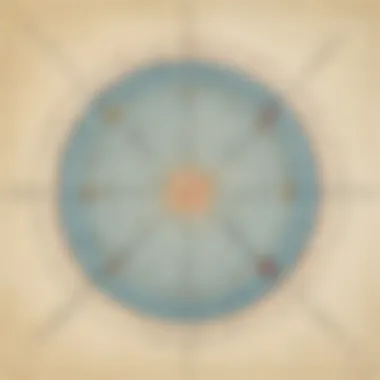Calculating Distance Between Two Points: A Comprehensive Guide


Intro
Understanding how to calculate the distance between two points is fundamental in mathematics and geometry. This concept not only enriches the fabric of mathematical knowledge but also serves practical applications in fields such as physics, engineering, and even daily navigation. In this guide, we will explore the distance formula that enables one to find the length between any two points in the Cartesian coordinate system.
This guide aims to present concepts in a clear and structured manner, making it accessible for all readers, from young students to parents. With detailed explanations and practical examples, the content holds educational value while remaining engaging.
Before delving into the specifics of calculating distance, let us highlight key points we will cover:
- The distance formula and its derivation
- Practical applications in real-world scenarios
- Related concepts of geometry and mathematics
- Tips for applying the knowledge in everyday life
Let’s embark on this mathematical journey, equipping ourselves with the necessary tools to calculate distances accurately.
Prologue to Distance Measurement
Distance measurement is foundational to understanding mathematics and geometry. It allows us to explore relationships between two points. In both academic and everyday contexts, grasping how to measure distance aids decision-making. Whether you find yourself plotting a course on a map or calculating the distance between two locations, this skill becomes invaluable.
Understanding Coordinates
Coordinates are a system that helps pinpoint locations in a two-dimensional space. In the Cartesian coordinate system, each point is represented by an ordered pair
- The first number indicates the horizontal position (x-axis).
- The second number indicates the vertical position (y-axis).
This simple structure allows for precise calculation and easy visualization of points. By using coordinates, we can translate real-world concepts into numerical form, facilitating effective distance measurement.
Importance of Measuring Distance
Measuring distance is not just a mathematical exercise; it has practical implications in daily life. For instance, knowing how far apart two locations are affects travel time and route planning. In science, accurate distance measurements inform a multitude of studies, from physics to environmental science. The precision in distance calculation can lead to enhanced understanding and productivity in numerous fields, pushing both academic and professional boundaries.
"Accurate distance measurement can significantly enhance our understanding of spatial relationships, ultimately leading to better decision-making."
Understanding these measurements forms a vital part of a well-rounded education. As we proceed through this article, we will dive deeper into the mechanics of measuring distance and the applications of such knowledge.
The Cartesian Coordinate System
The Cartesian coordinate system is vital in geometry and mathematics. It provides a framework for understanding and calculating distances in a two-dimensional space. This system uses two axes: the x-axis and the y-axis, which intersect at a point called the origin. By positioning points on this grid, you create a visual representation of mathematical concepts. This helps learners grasp the relationship between numbers and their graphical counterparts.
Defining the Axes
In the Cartesian coordinate system, each axis serves a distinct role. The x-axis runs horizontally, while the y-axis runs vertically. Each axis is divided into equal segments, marked by numbers that indicate distances from the origin.
- The x-axis represents the horizontal distance from the origin. Positive numbers extend to the right, while negative numbers extend to the left.
- The y-axis signifies vertical distance from the origin. Positive values go upwards and negative numbers downward.
Understanding these axes is crucial for plotting points accurately. When identifying coordinates, the first number refers to the x-axis while the second number relates to the y-axis. For example, the point (3, 2) indicates it is three units right of the origin and two units up.
Plotting Points on a Graph
Plotting points is a fundamental skill that relies heavily on understanding the axes. Each point on the graph corresponds to a unique pair of coordinates. To plot a point:
- Locate the x-coordinate on the x-axis.
- From that point, move vertically to find the y-coordinate on the y-axis.
- Mark the spot on the graph where these two coordinates meet.
This process might seem simple, but it forms the backbone of distance calculations and geometric concepts. For younger audiences, engaging in practical exercises, such as plotting points on paper, can solidify this learning process.
"Plotting is like unlocking the door to understanding geometry."
Correct plotting of points allows for more complex calculations and visualizations, enhancing one’s ability to solve mathematical problems effectively.
In summary, the Cartesian coordinate system helps define the space in which distance can be measured. It lays the groundwork for more intricate discussions surrounding distance, geometric interpretation, and mathematical applications. This understanding not only fosters confidence in elementary school students but also aids parents and caregivers in guiding their learning journey.
The Distance Formula Explained
Understanding the distance formula is essential for grasping how to measure the straight-line distance between two points in a coordinate system. The formula serves many applications, providing both a practical tool and a foundational concept in geometry. It simplifies complex measurements into an easily digestible format, allowing students and professionals alike to apply it effectively in various scenarios.
This section lays out the significance and overarching both theoretical and practical aspects of the distance formula, leading us to its derivation and application methods.
Derivation of the Formula
The distance formula stems from the Pythagorean theorem, which states that in a right-angled triangle, the square of the hypotenuse is equal to the sum of the squares of the other two sides. To derive the distance formula for two points, consider points A and B with coordinates (x₁, y₁) and (x₂, y₂).
- Begin by plotting A and B on a Cartesian plane.
- Draw a line connecting these points and form a right triangle with the x-axis and a vertical line extending from point B.
- The horizontal leg of the triangle represents the difference in x-coordinates (x₂ - x₁), and the vertical leg represents the difference in y-coordinates (y₂ - y₁).
- By applying the Pythagorean theorem:Distance = √[(x₂ - x₁)² + (y₂ - y₁)²]
This formula allows flexible calculations in any situation that involves distance measurement on a plane.
Applying the Formula
To apply the distance formula effectively, first identify the coordinates of the two points you wish to measure. Let’s go through an example:
Suppose you have two points: Point A (3, 4) and Point B (7, 1). To find the distance between them, follow these steps:
- Identify Points:
A = (3, 4)
B = (7, 1) - Calculate Differences:
- Square the Differences:
- Sum the Squares:
( 16 + 9 = 25 ) - Take the Square Root:
( √25 = 5
)


- For x-coordinates:
( 7 - 3 = 4 ) - For y-coordinates:
( 1 - 4 = -3 )
- (4)² = 16
- (-3)² = 9
Thus, the distance between points A and B is 5 units. Each of these steps uses clear arithmetic operations, ensuring accuracy in distance calculation without the need for advanced mathematics.
The distance formula provides not just a measurable outcome, but also a structured approach to visualizing relationships between points in space.
This clear, systematic method can now be utilized in longer or more complex distance calculations as needed, reinforcing foundational mathematical skills.
Step-by-Step Calculation
Calculating distance between two points is a fundamental skill in geometry and mathematics. This section emphasizes a systematic approach to ensure accuracy and understanding. Each step is designed to break down the process, making it clearer and easier to apply in different scenarios. By mastering each component, you enhance your problem-solving skills, which can lead to greater confidence in handling mathematical challenges.
Identifying Points
The first step in calculating distance involves identifying the coordinates of the points involved. This is crucial, as any mistake here can lead to incorrect results. Generally, points are denoted as (x1, y1) and (x2, y2).
When working on a grid, each point corresponds to specific values on the x-axis and y-axis. For example, if one point is located at (2, 3) and another at (5, 7), identifying them accurately sets the stage for the calculation. It's important to pay close attention to both the values and their positions to prevent errors.
Calculating Differences
Once the points are identified, the next step is to calculate the differences between their respective coordinates. This involves two simple subtractions:
- Calculate the difference in x-coordinates:( \Delta x = x_2 - x_1 )
- Calculate the difference in y-coordinates:( \Delta y = y_2 - y_1 )
Using our previous example, for points (2, 3) and (5, 7):
- ( \Delta x = 5 - 2 = 3 )
- ( \Delta y = 7 - 3 = 4 )
These differences help set up the next phase of the calculation.
Final Calculation Example
The final step combines the differences to compute the distance using the distance formula. The formula is:
[ d = \sqrt(\Delta x)^2 + (\Delta y)^2 ]
Plugging in the differences from our example:
[ d = \sqrt(3)^2 + (4)^2 ]
[ d = \sqrt9 + 16 = \sqrt25 = 5 ]
Thus, the distance between the points (2, 3) and (5, 7) is 5 units. This method not only provides clarity but also reinforces the foundational concepts of distance measurement. Understanding this step-by-step process paves the way for tackling more complex problems in geometry and beyond.
Geometric Interpretation of Distance
Understanding the geometric interpretation of distance is crucial for grasping how the distance between two points is defined and applied in various contexts. This section delves into the ways in which distance can be visualized and understood as a linear measure within a Cartesian coordinate system.
Visualizing Points on a Grid
When we plot points on a grid, we position them based on their coordinates, usually represented as (x, y). This format clearly indicates where each point lies in relation to the x-axis and y-axis. Visualizing points on a grid provides a foundational understanding of distance measurement.
- Coordinate System: In a standard two-dimensional grid, one can plot points by identifying their x and y values.
- Orientation: Points are aligned with respect to the horizontal and vertical axes, creating a clear framework for spatial reasoning. Each point is a distinct location that can be measured against others.
- Example: For coordinates (3, 4) and (7, 1), plotting these points visually illustrates their positions. The distance between them can be calculated using the distance formula, emphasizing the relationship in the visual context.
"Visual representation simplifies understanding the spatial relationship between points, making mathematical concepts more accessible."
This visualization aids in intuition and develops insights into how distance is not simply a numeric value but also represents a spatial relationship.
Distance as a Linear Measure
In geometry, distance is often viewed as a linear measure. This perspective allows one to grasp the concept of distance not just as a numerical output but as a fundamental characteristic of spatial relationships.
- Definition: Linear distance refers to the shortest path between two points in a straight line. This aspect can be quantified and is distinctly measurable through the distance formula derived from the Pythagorean theorem.
- Significance: Understanding distance as linear reinforces the importance of direction and magnitude in determining how far apart two points are. It highlights that even if points may appear to be close together on a grid, the actual distance must be calculated accurately to reflect their true separation.
- Applications: This concept extends into various fields, such as navigation, architecture, and computer graphics. It is essential in any scenarios where precise measurements are required.
Such understanding is essential, especially for young learners or those new to these concepts. Presenting distance in a geometric light enhances comprehension, ensuring learners see both the numeric and spatial dimensions of distance.
Applications of Distance Calculations
Distance calculations serve various purposes in our daily lives and in more advanced fields, such as technology and sciences. Understanding how to calculate distance is not just a mathematical exercise, but also a pivotal skill that can influence how we navigate and interact with the world. This section will delve into practical applications, highlighting why mastering distance calculations is essential.
In Everyday Life
Distance calculations play a significant role in our routine activities. Consider simple tasks such as measuring the distance between two locations when planning a trip. Knowing how far one place is from another helps in estimating travel time, which is crucial for planning schedules. For instance, if a parent is driving children to school, they need to know the distance to ensure they leave on time.
Moreover, this concept is evident in hobbies like jogging or cycling, where individuals often track their routes. Applications such as map services, including Google Maps, rely heavily on distance calculations to provide directions and travel estimates. The relevance does not stop there.
- Driving Directions: Tools help users understand how long it will take to reach their destination.
- Real Estate Decisions: Buyers often consider distances to schools or workplaces while choosing properties.
- Shopping: Local businesses might consider distance for delivery services, determining how far they can service customers efficiently.
In Technology and Sciences
In the realm of technology and sciences, distance calculations extend beyond simple measures. They are fundamental for various complex systems and applications. For example, GPS technology utilizes distance formulas to triangulate positions based on satellite signals. This process allows users to reroute effectively and find the shortest paths.
In scientific fields, particularly in physics, accurate distance measurements can impact results significantly. For instance, astronomers calculate distances to stars and galaxies to understand the universe’s structure. Additionally, the calculations often use the Pythagorean theorem to assess distances in multiple dimensions.


Some critical applications include:
- Robotics: Robots rely on distance measurements for navigation and obstacle avoidance.
- Data Analysis: In machine learning, distance metrics help algorithms classify data points effectively, influencing model accuracy.
- Healthcare: Telemedicine leverages distance for remote diagnosis and patient care, allowing doctors to guide patients from afar.
Knowing how to calculate and apply distance measurements affects diverse aspects of life and technology. This awareness equips individuals with valuable skills for personal and professional settings.
Common Mistakes in Distance Calculation
Distance calculation can often appear straightforward. However, several common mistakes can lead to wrong results. These mistakes arise from misunderstandings of the concepts or simple errors. Understanding these errors is crucial for both students and practitioners. Knowing where errors typically occur helps in achieving more accurate calculations. This section outlines some frequent pitfalls and why it's important to avoid them.
Misidentifying Coordinates
A major mistake in calculating distance comes from misidentifying coordinates. It can happen when points are plotted on a graph or when reading values from a table. For instance, mixing up the x-coordinate and the y-coordinate is a simple error. This error significantly impacts the final distance. When coordinates are identified incorrectly, even the most skilled calculations can produce substantially flawed results.
Additionally, it is common for students to confuse positive and negative values. This misunderstanding can stem from not paying attention to signs. In some cases, coordinates may seem similar, but the sign switched leads to a wrong distance result. It's essential to be careful and double-check the coordinates before proceeding with distance calculations.
Errors in Mathematical Operations
It is not enough simply to identify the correct coordinates; the subsequent mathematical calculations must also be accurate. Errors in operations such as addition, subtraction, multiplication, or square root calculations are frequent. A small mistake in one of these operations can lead to wide discrepancies in the final distance. These mistakes often arise from rushing through the calculations or misunderstanding the order of operations.
A good practice is to review the calculations step by step. Here are some tips to minimize mathematical errors:
- Break down calculations: Tackle complex problems in smaller segments.
- Use a calculator carefully: Ensure the inputs are correct to avoid simple input errors.
- Check work: After completing the calculations, retrace your steps to verify results.
"Mistakes are proof that you are trying." Identifying and learning from errors is a crucial part of mastering distance calculations and mathematics in general.
Avoiding these common mistakes will lead to more reliable and accurate distance calculations. Understanding where errors lie can greatly improve the quality of both educational learning and practical application.
Understanding Related Mathematical Concepts
In the realm of distance calculation, related mathematical concepts provide essential frameworks that enrich understanding. These concepts build a foundation for how distance is perceived and calculated. Learning about them deepens comprehension and reveals the connections between different areas of mathematics.
Understanding these frameworks can be beneficial in various ways. First, it enhances problem-solving abilities, allowing students to apply learned concepts practically. Second, these principles offer tools for analyzing real-world scenarios where distance plays a critical role. Finally, grasping these concepts can stimulate interest in higher mathematics, encouraging further exploration.
The Pythagorean Theorem
The Pythagorean Theorem is a fundamental principle in mathematics, describing a special relationship between the sides of a right triangle. It states that in any right triangle, the square of the length of the hypotenuse is equal to the sum of the squares of the lengths of the other two sides. This can be expressed with the equation:
a² + b² = c²
where c represents the hypotenuse, and a and b represent the other two sides. This theorem is directly tied to distance calculation, especially in the Cartesian plane. When finding the distance between two points, the Pythagorean Theorem simplifies the process by allowing the measurement of the horizontal and vertical distances separately.
For example, if points A (2, 3) and B (5, 7) are plotted on a graph, the difference in x-coordinates is 3, and the difference in y-coordinates is 4. Applying the theorem gives:
3² + 4² = 9 + 16 = 25
Thus, the distance is √25 = 5. This highlights the theorem's practicality.
Concept of Euclidean Space
Euclidean space is a foundational concept in mathematics that describes a two-dimensional or three-dimensional space where the familiar geometry operates. In a two-dimensional Euclidean space, defined by an x-axis and y-axis, distance, angles, and shapes can be analyzed using established geometric rules. This concept provides a context where political ideas like parallelism and congruence apply.
The clarity of Euclidean space helps in visualizing points and their relationships. Understanding this space is crucial for distance calculations, especially when working within the Cartesian coordinate system. The principles governing this space allow for the unique identification of points based on their coordinates.
In summary, Euclidean space not only plays a pivotal role in simplifying the concept of distance but also supports various applications in engineering, physics, and even computer graphics. By grasping these concepts, learners can better appreciate the principles underpinning distance measurement.
Advanced Distance Calculations
Advanced distance calculations are essential for understanding the complexities of measuring distance in various contexts. While basic calculations focus primarily on the Cartesian system, advanced methods consider multiple dimensions and diverse geometrical frameworks. This section outlines the significance of these topics, emphasizing their relevance in pragmatic applications.
Distance on a Sphere
Calculating distance on a sphere introduces a layer of complexity not found in flat surfaces. This method is crucial for understanding geographical distances. For instance, the shortest path between two points on the Earth’s surface is along the curve of a great circle. This is often the path taken by airplanes and ships.
The formula for distance on a sphere can be derived from the law of cosines or through spherical coordinates. For two points with latitude and longitude coordinates, the haversine formula or Vincenty’s formula is often utilized. These formulas give more accurate results than a simple planar calculation would.
Important considerations include the spherical nature of the Earth, which affects calculations especially for long distances. Simple calculations could lead to substantial errors when distances stretch over large areas. Taking this additional complexity into account is vital in fields such as navigation and aviation.
Applications in Navigation
Advanced distance calculations play a critical role in navigation, particularly in maritime and aerial contexts. The ability to measure distances accurately on a sphere allows navigators to plot courses efficiently and effectively. This precision helps avoid hazards and optimize travel routes.
Some key points include:
- Global Positioning Systems (GPS) leverage spherical calculations to provide accurate positioning information.
- Sailing incorporates these calculations to determine the quickest routes over oceanic expanses.
- Aviation relies on great circle routing for fuel efficiency and time savings.
Understanding advanced distance measurements ensures safety and improves operational efficiency in transportation. Mastery of these concepts enhances not only academic knowledge but also practical skills required in real-world applications.
Visual Tools for Distance Measurement


Visual tools for distance measurement play a crucial role in understanding and applying the concepts discussed in this article. These tools serve not only as aids in accomplishing mathematical tasks but also foster a deeper comprehension of spatial relationships and geometric principles. By visually presenting data and calculations, users gain insight into how distance is represented on graphs, as well as the relationships between different points in a coordinate system. This section will discuss two major tools: graphing calculators and online measurement tools.
Graphing Calculators
Graphing calculators can dramatically enhance the way students and educators approach the calculation of distance between points. These devices allow users to input equations and view graphs on a screen where relationships between points become clearer. The functionality goes beyond mere calculation; it enables visual representation of geometric shapes and lines. Such visual feedback can help learners understand not just the end result of their calculations, but also the concept of distance as it applies to the coordinate plane.
Benefits of Using Graphing Calculators:
- Visualization: Students can see points being plotted in real time. This visualization helps in grasping the concept of coordinates and distance.
- Multiple Functions: They can perform several calculations, including those for various mathematical functions, making them versatile for learning.
- Immediate Feedback: Users receive instantaneous results, which is essential for learning through experimentation and error correction.
One consideration with graphing calculators is that they may be intimidating for some younger students. Thus, educators should provide guidance on how to effectively use these tools to maximize their benefit.
Online Measurement Tools
Online measurement tools are increasingly popular among learners and educators for distance calculation. These tools offer similar functionalities to graphing calculators but are more accessible since they can be used from any device with internet connectivity. Websites can provide interactive graphs where users can click and drag to measure distances between points directly.
Benefits of Online Measurement Tools:
- Accessibility: They can be accessed from home, school, or anywhere with an internet connection.
- User-Friendly Interfaces: Many online tools are designed to be intuitive, allowing even younger students to navigate them with ease.
- Diverse Applications: These tools not only measure distances but offer additional resources such as tutorials and practice problems.
Some popular online tools include applications that allow for measurements on maps or coordinate grids. However, users should verify the accuracy of these tools, especially when using them for precise calculations.
In summary, using visual tools for distance measurement can greatly empower students in their learning journey. By applying their knowledge with graphing calculators and online tools, learners not only enhance their practical skills but also deepen their understanding of mathematical concepts.
Educational Resources for Learning Distance Calculation
Understanding how to calculate distance between two points is fundamental in mathematics. However, it can be challenging for some learners. Educational resources play a crucial role in bridging the gap between theory and application. These resources help learners grasp the nuances of distance measurement, reinforcing concepts through varied methods, which cater to different learning styles.
When students have access to quality educational materials, it enhances their ability to solve problems effectively. Resources like books, online courses, and tutorials provide different perspectives on the topic. They allow learners to approach distance calculations systematically and build confidence in their skills. Key considerations include the quality of the materials, accessibility, and relevance to the curriculum.
"Access to the right educational resources can make the difference between confusion and clarity in math learning."
Books and Textbooks
Books and textbooks serve as foundational tools in learning distance calculation. They often provide comprehensive explanations and curated examples. When selecting a book, look for those that include clear diagrams and step-by-step instructions. Good texts will usually start with basic principles before advancing to more complex applications.
Here are some benefits of using books and textbooks:
- Structured Learning: They offer a systematic approach to understanding distance measurement, ensuring that students can follow logically from one concept to the next.
- In-Depth Analysis: Textbooks often delve deeper into related mathematical concepts. This depth helps students make connections between distance and other areas in mathematics.
- Practical Exercises: Many books include problems for practice, allowing students to reinforce what they have learned.
Some notable examples include "Elementary Geometry for College Students" by Daniel C. Agrawal, which has straightforward chapters on distance calculation that are approachable even for younger audiences.
Online Courses and Tutorials
In this digital age, online courses and tutorials present new opportunities for learning distance calculation. They provide flexibility and allow students to learn at their own pace. These courses often incorporate multimedia elements, such as videos, which can enhance understanding.
Key advantages of online courses include:
- Interactive Learning: Most online platforms offer quizzes, forums, and feedback mechanisms. This interaction can help students clarify doubts and engage with the material more effectively.
- Accessibility: Many online resources are free or low-cost, making education more accessible to a wider audience, including parents and caregivers.
- Diverse Formats: From video tutorials to interactive quizzes, the variety caters to different learning styles, helping ensure that complex topics are understood.
Websites like Khan Academy and Coursera have excellent resources for students interested in learning distance calculations. These platforms can help transform a challenging subject into an engaging and enjoyable learning experience.
Summary of Key Points
In this section, we summarize the crucial points related to the calculation of distance between two points. Understanding these key elements enhances comprehension and provides a solid foundation for future learning.
Calculating distance is essential in various fields, from basic geometry to complex physics. It allows for practical application in everyday life, such as determining the length of a trip or the space between objects. Accurate distance measurement ensures precision in results, supporting effective planning and decision-making.
Recap of the Distance Formula
The distance formula is derived from the Pythagorean theorem, which relates the lengths of the sides of a right triangle. The formula to determine the distance, d, between two points ((x_1, y_1)) and ((x_2, y_2)) in a two-dimensional space is as follows:
[ d = \sqrt(x_2 - x_1)^2 + (y_2 - y_1)^2 ]
This formula simplifies the process of finding the distance and is applicable in various scenarios, including technology and navigation. By plugging in the values of the coordinates, one can find the distance 'd' easily.
Highlights of Applications
The applications of distance measurement extend far beyond theoretical learning. Some significant areas include:
- Navigation: Calculating distances enables effective route planning and navigation, essential for travel and transportation.
- Architecture and Engineering: Accurate distance measurement is fundamental in design and construction, ensuring safety and compliance with standards.
- Sports and Fitness: Understanding distances can enhance training programs and performance analytics in sports.
- Geographic Information Systems (GIS): Works by measuring distances between geographical points, critical for mapping and land use planning.
The versatility of distance measurement makes it vital in educational curriculums, fostering skills applicable across multiple domains.
Understanding how to calculate distances can pave the way for students to engage more deeply with STEM subjects and realize their real-world relevance.
Culmination
In this article, we have examined the various aspects of calculating the distance between two points. Understanding how to measure distance is essential for many practical applications, from navigation to computer graphics. The distance formula serves as the core concept, allowing users to derive distances efficiently using coordinates.
The benefits of mastering distance calculation extend beyond academics. It fosters critical thinking and problem-solving skills in real-life situations. For children, grasping these concepts early can build a strong foundation in math. Parents and caregivers play a crucial role by encouraging exploration of these ideas, making learning engaging.
Additionally, this guide highlighted common mistakes made in calculations, emphasizing the importance of accuracy in mathematical operations. Errors can lead to significant misunderstandings in various fields. By recognizing these pitfalls, learners can avoid them and confidently apply distance formulas in practical scenarios.
Furthermore, the section on applications in technology and science underscores the relevance of distance calculations in everyday life. Understanding these principles empowers individuals to appreciate their surroundings and enhances spatial awareness.
As we summarize the key points, it is clear that solidifying knowledge about distance measurement equips readers with valuable tools. The discussion not only covers theoretical aspects but also practical applications, making it relevant for various audience segments.
Distance calculation is not just a mathematical exercise; it is a gateway to understanding the world around us.







